
Internal linking makes a huge difference. For automotive parts websites, strategic internal links can transform your SEO performance and sales results. I've seen countless auto parts sellers focus solely on product pages while neglecting the powerful connections between their content.
Why does this matter? Search engines use internal links to discover your pages, understand relationships between content, and distribute authority throughout your site. For automotive websites with hundreds or thousands of parts, proper internal linking becomes even more critical for both search engines and users.
In this guide, I'll share practical internal linking strategies specifically for automotive and aftermarket parts websites. These approaches have helped our clients improve visibility, increase organic traffic, and boost sales without requiring massive content investments.
Internal links connect pages within your automotive website. They serve as pathways for both users and search engines to navigate your site effectively. For auto parts websites, these connections create a logical structure that showcases product relationships and helps establish content hierarchy.
Think about how complex automotive inventories can get. You might have thousands of parts across dozens of categories, compatible with various makes and models. Without proper internal linking, this complexity becomes overwhelming for both users and search engines.
Internal links solve three key challenges for automotive websites:
Many automotive websites make critical mistakes with their internal linking. These errors limit SEO potential and create barriers to growth.
The table above highlights how common linking mistakes can specifically impact automotive websites. By understanding these pitfalls, you can develop a more effective approach to your site structure.
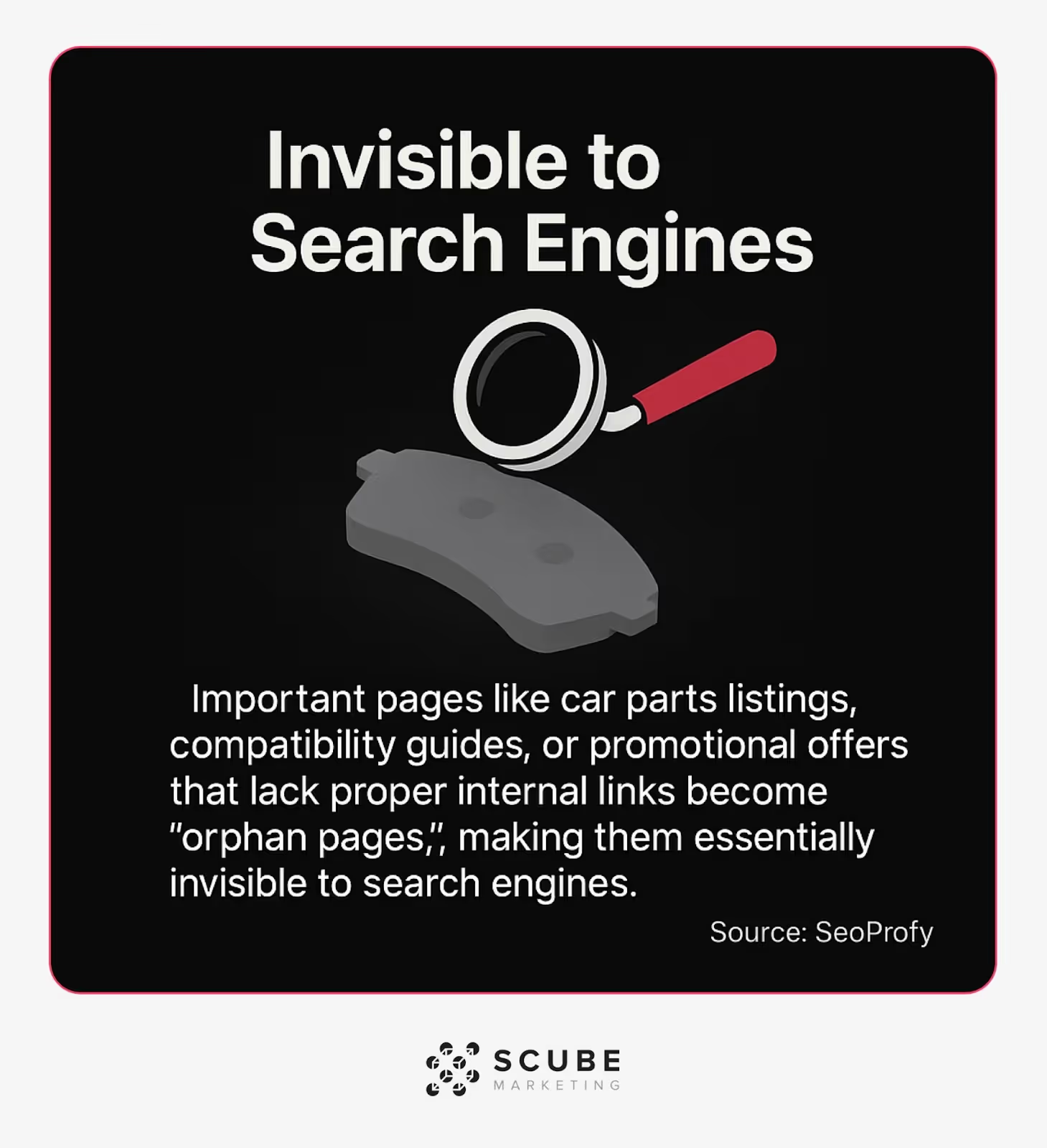
Important pages like car parts listings, compatibility guides, or promotional offers that lack proper internal links become "orphan pages," making them essentially invisible to search engines. (Source: SeoProfy)
Internal links play a crucial role in determining how search engines understand and rank your automotive website. The impact extends beyond simple navigation benefits.
When Google crawls your site, it follows links to discover content. With a solid internal linking structure, search engines can efficiently find and index your entire parts catalog. This ensures all your products have the opportunity to appear in search results.
But the benefits go deeper. Internal links transfer authority between pages on your site. This concept, sometimes called "link juice," means your strongest pages can help boost others that need ranking improvements.
For automotive websites, this creates valuable opportunities. You can strategically link from high-authority blog content or popular category pages to specific product listings that need visibility boosts.
The authority distribution aspect deserves special attention. Internal links effectively allow you to vote for your most important pages. For automotive parts sellers, this means you can prioritize seasonal products, high-margin items, or competitive categories through strategic internal linking.
Developing an effective internal linking structure requires planning. For automotive websites, the right approach creates logical pathways without overwhelming users or diluting link value.
Before diving into specific tactics, we need to understand the fundamental patterns that work best for automotive sites. The right structure depends on your inventory organization, target audience, and business goals.
Each pattern offers distinct advantages, and many successful automotive sites combine multiple approaches. Let's explore the most effective implementations for each strategy.
The foundation of automotive SEO starts with strong category-to-product linking. This creates the primary pathways search engines use to discover your inventory.
For optimal results, organize parts by vehicle compatibility, function, or type depending on how customers typically search. Each category page should link to all relevant products, while products should link back to their parent categories.
Consider this example structure for a performance parts retailer:
1. Main category: Performance Parts
- Subcategory: Engine Performance
- Product type: Turbochargers
- Individual product pages
This hierarchy creates clear pathways for both users and search engines. Each level provides context that helps establish relevance and authority.
Cross-linking between related categories also strengthens your site structure. For instance, linking between "Engine Performance" and "Fuel Systems" categories signals their relationship and helps users discover relevant complementary products.
When organizing your automotive category structure, it's essential to consider how customers search for and purchase auto parts online? Understanding their buying journey helps you create intuitive category paths that match search behavior.
Blog content creates powerful opportunities for internal linking. Educational articles, buying guides, and how-to content naturally attract visitors who may not be ready to purchase immediately.
Strategic links from this content to relevant product pages create conversion pathways. For example, an article about "How to Improve Engine Performance" can link to specific products mentioned in the content.
The key is making these links valuable to the reader. They should appear naturally within the content, offering additional information or solutions related to what the user is reading.
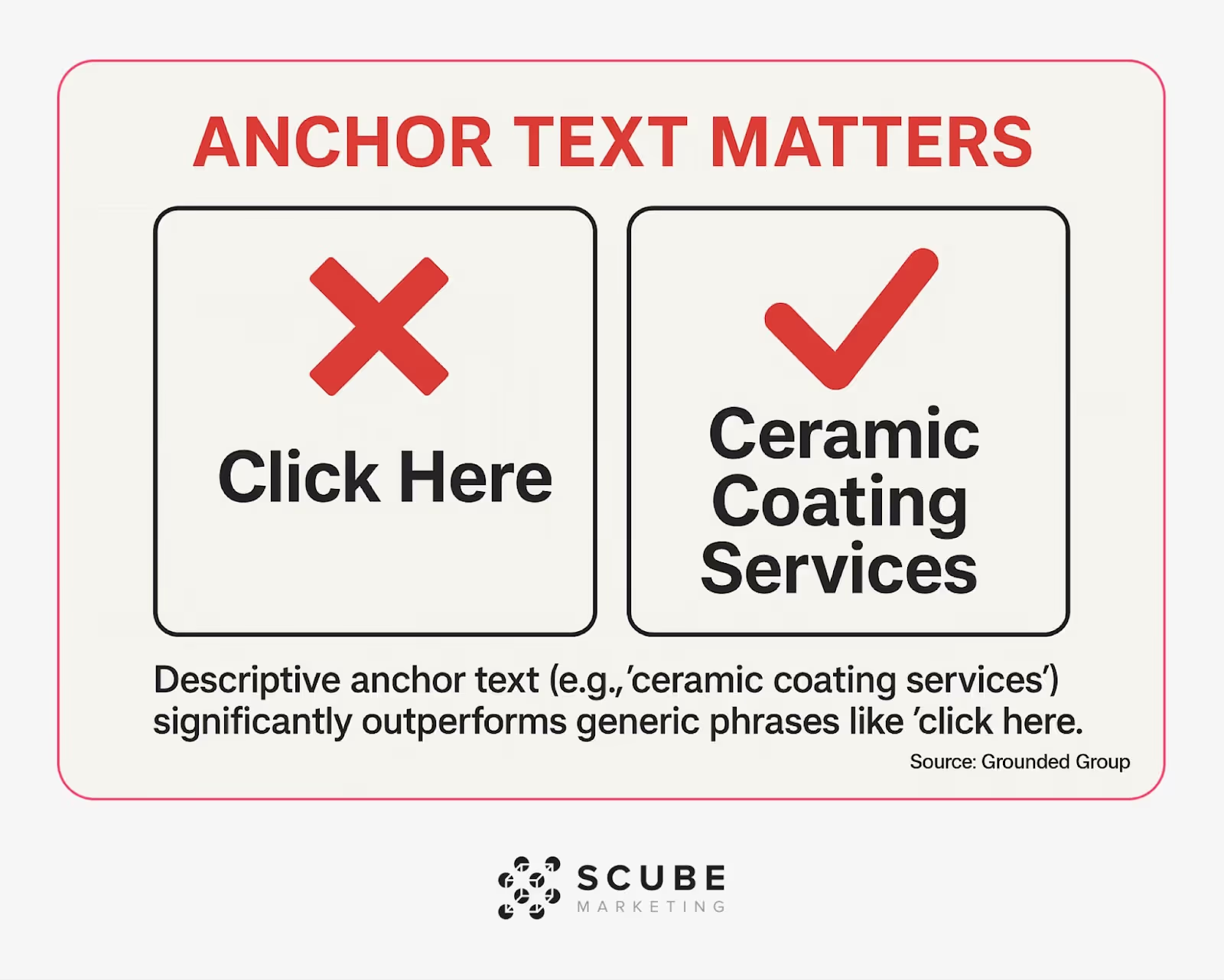
Descriptive anchor text (e.g., "ceramic coating services") significantly outperforms generic phrases like "click here" for SEO purposes. (Source: Grounded Group)
For automotive content, effective anchor text might include:
- Specific part names ("K&N cold air intake")
- Product categories ("performance brake rotors")
- Solution-oriented phrases ("oil additives for high-mileage engines")
These descriptive links provide context to both users and search engines about the destination page's content.
The silo structure represents one of the most effective approaches for large automotive parts inventories. This method organizes content into distinct categories with strong internal linking within each category but limited cross-category linking.
For an automotive parts website, silos might be organized by:
- Vehicle makes and models
- Part types and categories
- Performance domains (engine, suspension, etc.)
- Brands or manufacturers
Each silo contains a hierarchy with main category pages linking to subcategories and products. The key benefit is creating strong topical relevance signals for each segment of your inventory.
To implement this structure effectively:
1. Identify your main category silos
2. Create strong internal links within each silo
3. Use breadcrumb navigation to reinforce the hierarchy
4. Link from the homepage to each main silo page
5. Add limited cross-linking between related silos where relevant
This approach helps search engines understand your content organization and can significantly improve rankings for competitive automotive parts searches.
Now that we understand the strategic patterns, let's explore practical tactics for implementing internal links on automotive websites. These approaches can be applied regardless of your platform or current site structure.
Effective implementation requires both technical understanding and strategic thinking. The goal is creating meaningful connections that help users and search engines navigate your inventory logically.
Before adding new links, assess your current structure. An internal link audit reveals opportunities and issues that might be limiting your performance.
Start by identifying orphaned pages. These are product listings or content pages that have no internal links pointing to them. On automotive sites, orphaned pages often include older model compatibility guides, discontinued parts that might still have search value, or new products that haven't been integrated into the navigation.
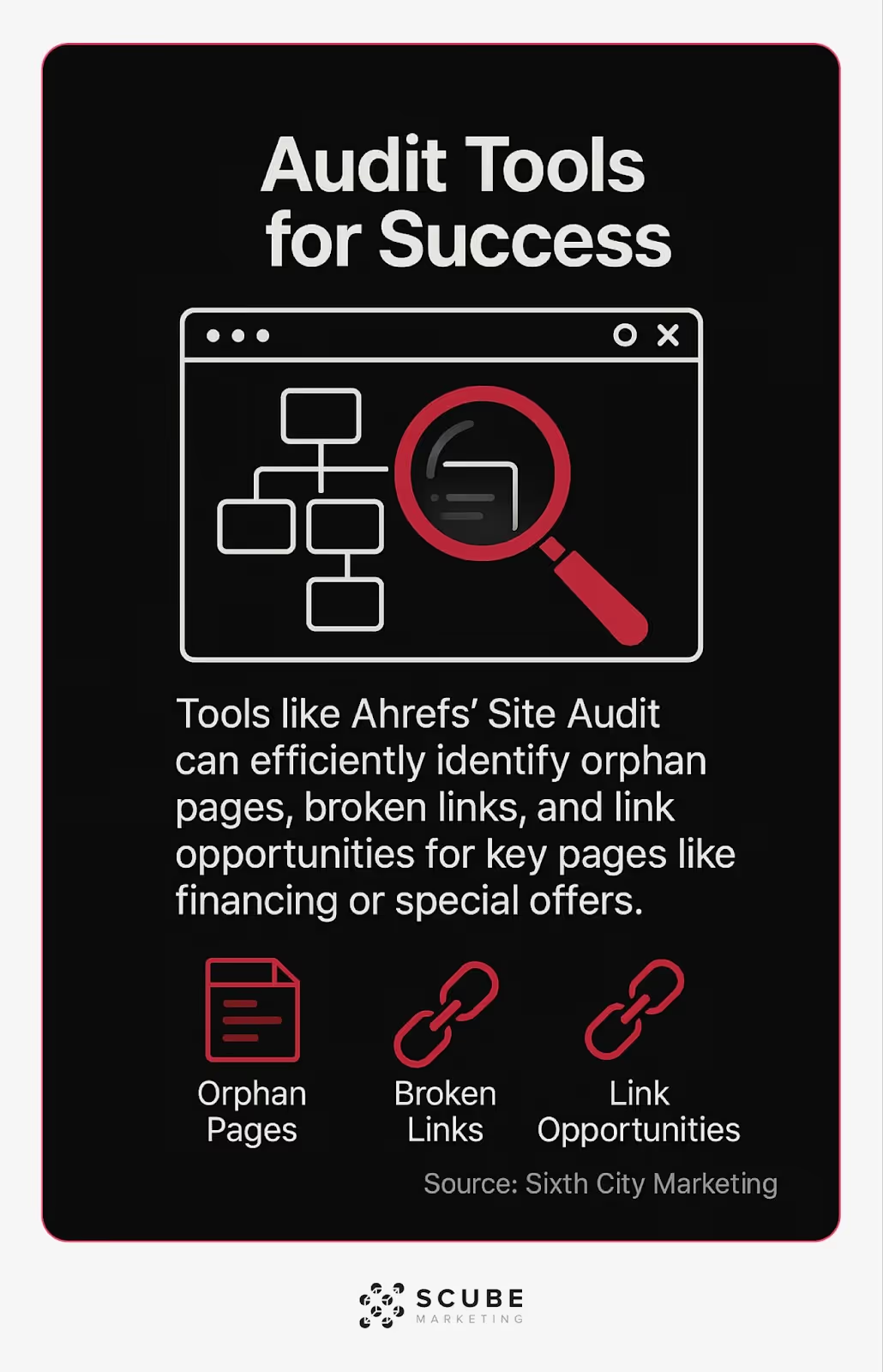
Tools like Ahrefs' Site Audit can efficiently identify orphan pages, broken links, and link opportunities for key pages like financing or special offers. (Source: Sixth City Marketing)
Your audit should answer these key questions:
After completing your audit, prioritize fixes based on potential impact. Focus first on connecting orphaned pages, then optimize existing links with better anchor text, and finally add strategic new links.
The words you use in your links matter significantly. Anchor text provides context about the destination page to both users and search engines. For automotive websites, descriptive anchor text creates stronger relevance signals.
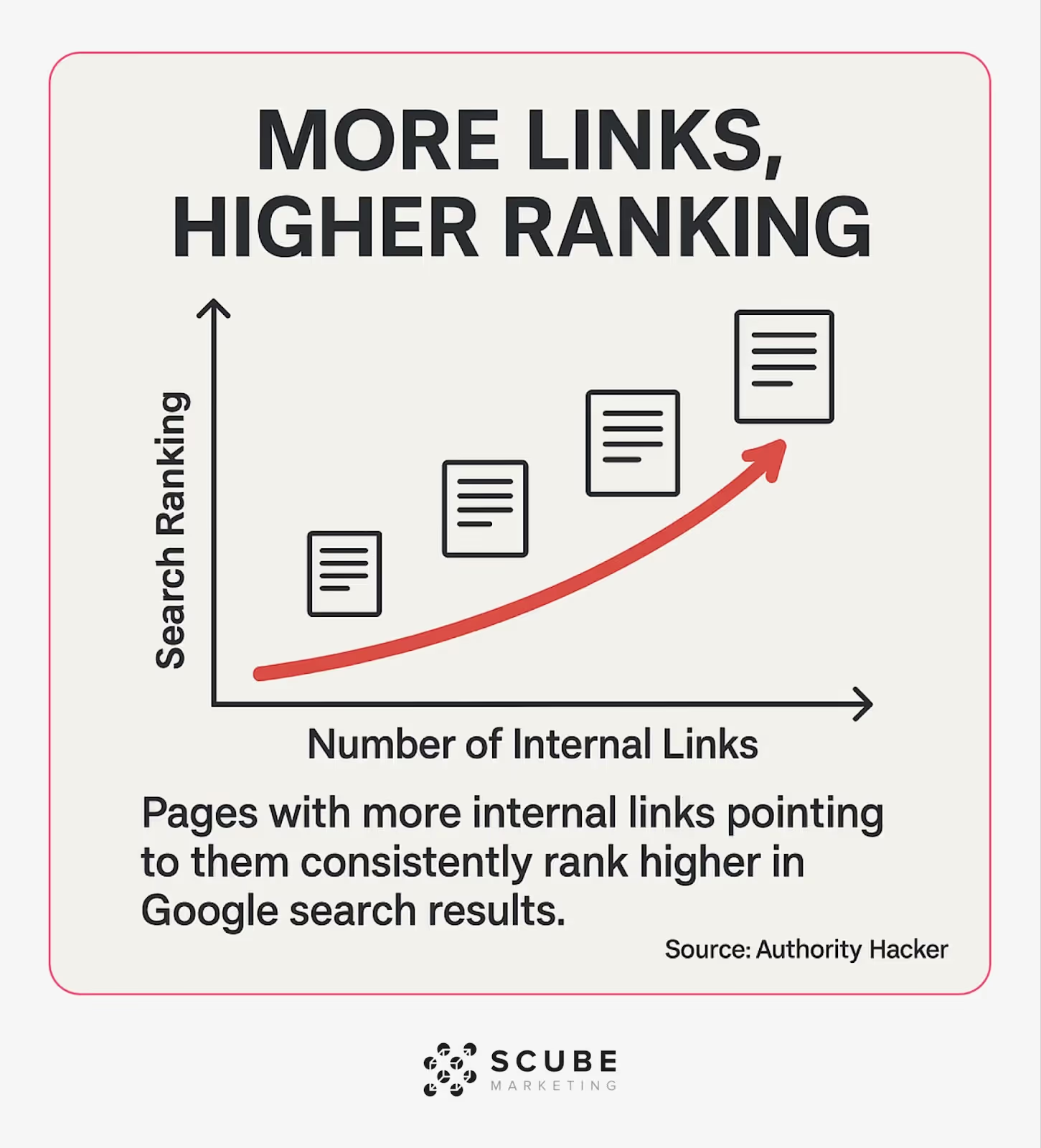
Pages with more internal links pointing to them consistently rank higher in Google search results. (Source: Authority Hacker)
Compare these approaches:
The descriptive versions clearly communicate what users will find on the linked page. This improves user experience while providing valuable context to search engines about content relationships.
While using descriptive anchor text is important, avoid over-optimization. Vary your phrasing naturally, and don't force exact-match keywords into every link. A balanced approach that prioritizes user understanding works best.
Implementing an effective internal linking strategy can be challenging for large automotive sites. Fortunately, several tools can simplify the process.
Beyond these tools, developing a consistent internal linking policy helps maintain structure as your site grows. Document guidelines for:
1. How many internal links should appear in new content
2. Which anchor text formats to use for different product types
3. Priority pages that should receive more internal links
4. How to handle discontinued products or models
With these resources and guidelines, you can implement a scalable internal linking approach that grows with your automotive parts inventory.
After implementing internal linking improvements, measuring their impact helps validate your approach and identify further optimization opportunities. Several metrics provide insight into how your changes affect both search performance and user behavior.
The most obvious metric is organic traffic growth to previously underperforming pages. After adding strategic internal links, these pages should receive more visibility in search results and consequently more visits.
But traffic isn't the only indicator of success. Consider these key performance metrics:
For automotive websites, prioritize linking blog content (e.g., "New vs Used Cars") to conversion-focused pages like inventory listings. (Source: Automotive Dive)
To establish a proper baseline, document these metrics before making internal linking changes. After implementation, allow 2-4 weeks for search engines to recrawl your site before comparing results.
Significant improvements in crawl frequency and indexation typically appear first, followed by ranking improvements and traffic increases. User behavior metrics like page depth and click paths often show immediate changes as visitors discover new navigation paths.
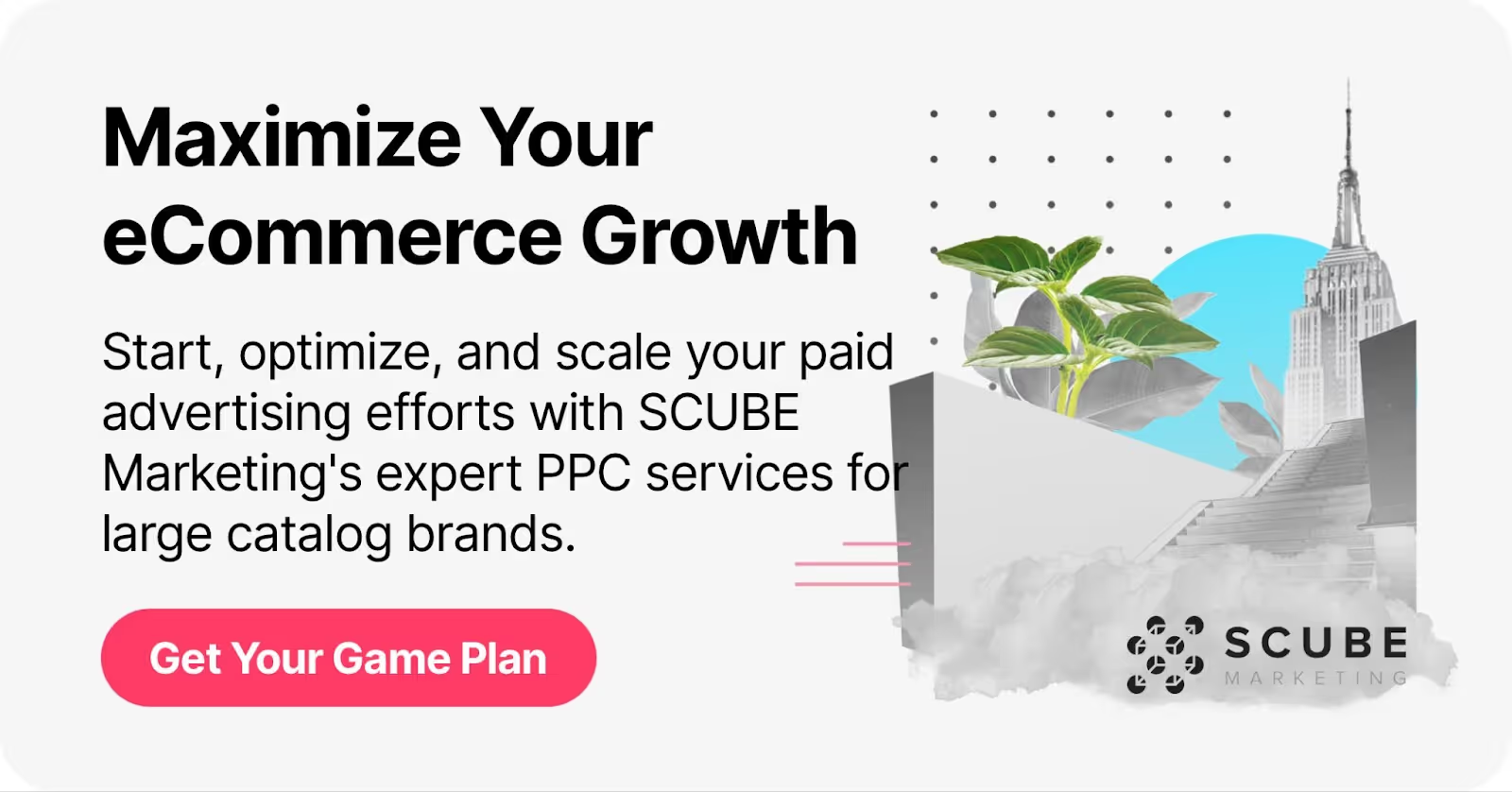
Effective internal linking transforms how search engines and users interact with your automotive parts website. The strategies we've covered provide a roadmap for improving your site structure and boosting SEO performance.
Remember that internal linking is not a one-time task but an ongoing process. As you add new products, create content, or update your site, maintain consistent linking practices to preserve your structure.
To get started with implementation:
1. Begin with an internal link audit to identify current gaps
2. Develop a strategic linking pattern that matches your inventory structure
3. Fix orphaned pages by adding relevant internal links
4. Optimize anchor text to be descriptive and valuable
5. Measure performance changes and refine your approach
For automotive parts retailers, the right internal linking strategy creates significant competitive advantages. It improves visibility for your entire inventory while enhancing user experience and driving more conversions.
If you're looking for a more comprehensive approach to boosting your aftermarket auto parts ecommerce success, consider how internal linking fits within your broader SEO and user experience strategy.
What internal linking improvements will you implement first? Start with the highest-impact opportunities, then systematically build a stronger site structure that serves both users and search engines.